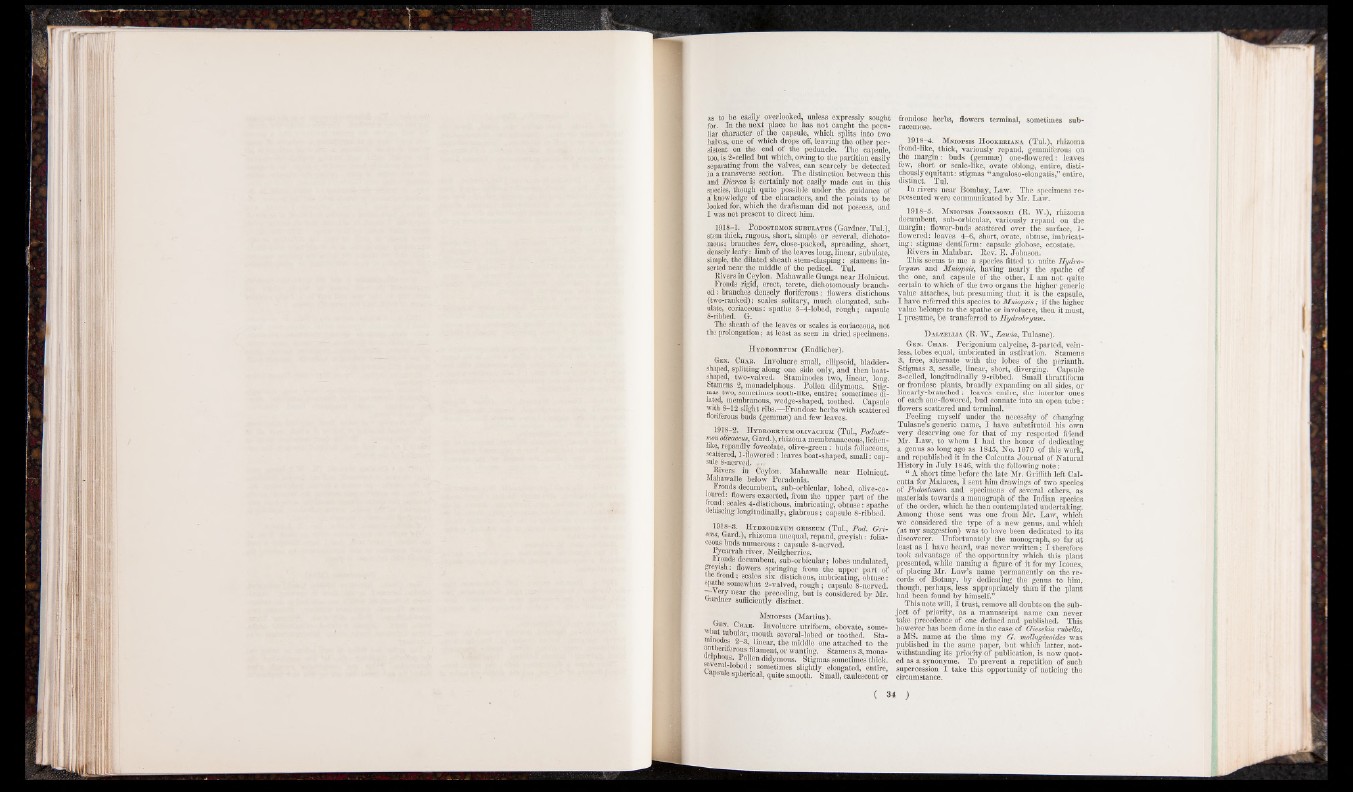
as to be easily overlooked, unless expressly sought
for. In the next place he has not caught the peculiar
character of the capsule, which splits into two
halves, one of which drops off, leaving the other persistent
on the end of the peduncle. The capsule,
too, is 2-celled but which, owing to the partition easily
separating from the valves, can scarcely be detected
in a transverse section. The distinction between this
and Theresa is certainly not easily made out in this
species, though quite possible under the guidance of
a knowledge of the characters, and the points to be
looked for, which the draftsman did not possess, and
I was not present to direct him.
1918-1. Podostemon SUBULATUS (Gardner, Tul.),
stem thick, rugous, short, simple or several, dichotomous;
branches few, close-packed, spreading, short,
densely leafy : limb of the leaves long, linear, subulate,
simple, the dilated sheath stem-clasping: stamens inserted
near the middle of the pedicel. Tul.
Rivers in Ceylon. Mahawalle Gunga near Holnicut.
Fronds rigid, erect, terete, dichotomously branched:
branches densely floriferous: flowers distichous
(two-ranked); scales solitary, much elongated, subulate,
coriaceous: spathe 3-4-lobed, rough; capsule
8-ribbed. G.
The sheath of the leaves or scales is coriaceous, not
the prolongation; at least as seen in dried specimens.
H ydrobryum (Endlicher).
Gen. Char. Involucre small, ellipsoid, bladdershaped,
splitting along one side only, and then boatshaped,
two-valved. Staminodes two, linear, long.
Stamens 2, monadelphous. Pollen didymous. Stigmas
two, sometimes tooth-like, entire; sometimes dilated,
membranous, wedge-shaped, toothed. Capsule
with 8-12 slight ribs.—Frondose herbs with scattered
floriferous buds (gemmae) and few leaves.
mon olivaceus, Gard.), rhizoma membranaceous, lichenlike,
repandly foveolate, olive-green : buds foliaceous,
scattered, 1-flowered : leaves boat-shaped, small: capsule
8-nerved. ,,,
Rivers in Ceylon. Mahawalle near Holnicut.
Mahawalle below Peradenia.
Fronds decumbent, sub-orbicular, lobed, olive-coloured:
flowers exserted, from the upper part of the
frond: scales 4-distichous, imbricating, obtuse: spathe
dehiscing longitudinally, glabrous ; capsule 8-ribbed.
1918-3. H ydrobryum griseum (Tul., Pod. Gri-
sm , Gard.), rhizoma unequal, répand, greyish : foliaceous
buds numerous : capsule 8-nerved.
Pycarrah river, Neilgherries.
Fronds decumbent, sub-orbicular; lobes undulated,
greyish : flowers springing from the upper part of
tue frond ; scales six distichous, imbricating, obtuse :
spathe somewhat 2-valved, rough ; capsule 8-nerved.
Very near the preceding, but is considered by Mr.
Gardner sufficiently distinct.
Mniopsis (Max-tius).
G-en. Char. Involucx-e utriform, obovate, some-
wnat tubular, mouth several-lobed or toothed. Sta-
minodes 2-3, linear, the middle one attached to the
ntneriferous filament, or wanting. Stamens 3, mona-
eipnous. Pollen didymous. Stigmas sometimes thick,
several-lobed; sometimes slightly elongated, entire,
apsuie spherical, quite smooth. Small, caulescent or
frondose herbs, flowers tei’minal, sometimes sub-
racemose.
1918-4. Mniopsis H ookeriana (Tul.), rhizoma
frond-like, thick, variously repand, gemmiferous on
the margin: buds (gemmae) one-flowered: leaves
few, short or scale-like, ovate oblong, entire, disti-
chouslyequitant: stigmas “ anguloso-elongatis,” entire,
distinct. Tul.
In l’ivers near Bombay, Law. The specimens represented
were communicated by Mi*. Law.
1918-5. Mniopsis J ohnsonh (R. W.), rhizoma
decumbent, sub-orbicular, variously repand on the
margin; flower-buds scattered over the surface, 1-
flowered: leaves 4-6, short, ovate, obtuse, imbricating:
stigmas dentiform: capsule globose, eeostate.
Rivers in Malabar. Rev. E. Johnson.
This seems to me a species fitted to unite Hydrobryum
and Mniopsis, having nearly the spathe of
the one, and capsule of the other, I am not quite
certain to which of the two organs the higher generic
value attaches, but pi*esuming that it is the capsule,
I have referred this species to Mniopsis; if the higher
value belongs to the spathe or involucre, then it must,
I presume, be transferred to Hydrobryum.
D a l z eix ia (R. W., Zawia, Tulasne).
Gen. Char. Perigonium calycine, 3-pai*ted, veinless,
lobes equal, imbi-icated in «estivation. Stamens
3, free, alternate with the lobes of the perianth.
Stigmas 3, sessile, linear, short, diverging. Capsule
3-celled, longitudinally 9-ribbed. Small thrattiform
or frondose plants, broadly expanding on all sides, or
linearly-branched: leaves entire, the interior ones
of each one-flowered, bud connate into an open tube:
flowers scattei*ed and terminal.
Feeling myself under the necessity of changing
Tulasne’s generic name, I have substituted his own
very deserving one for that of my respected friend
Mr. Law, to whom I had the honor of dedicating
a genus so long ago as 1845, Ho. 1070 of this work,
and republished it in the Calcutta Journal of Natural
History in July 1846, with the following n ote:
“ A short time befoi*e the late Mr. Griffith left Calcutta
for Malacca, I sent him drawings of two species
of Podostemon and specimens of several others, as
materials towards a monograph of the Indian species
of the order,, which he then contemplated undertaking.
Among those sent was one from Mr. Law, which
we considered the type of a new genus, and which
(at my suggestion) was to have been dedicated to its
discoverer. Unfoi*tunately the monograph, so far at
least as I have heard, was never written; I therefore
took advantage of the opportunity which this plant
presented, while naming a figure of it for my leones,
of placing Mr. Law’s name pennanently on the records
of Botany, by dedicating the genus to him,
though, perhaps, less appropriately than if the plant
had been found by himself.”
This note will, I trust, remove all doubts on the subject
of priority, as a manuscript name can never
take precedence of one defined and published. This
however has been done in the case of Giesekia rubella,
a MS. name at the time my G. molluginoides was
published in the same paper, but which latter, notwithstanding
its priority of publication, is now quoted
as a synonyme. To prevent a repetition of such
supercession I take this opportunity of noticing the
circumstance.